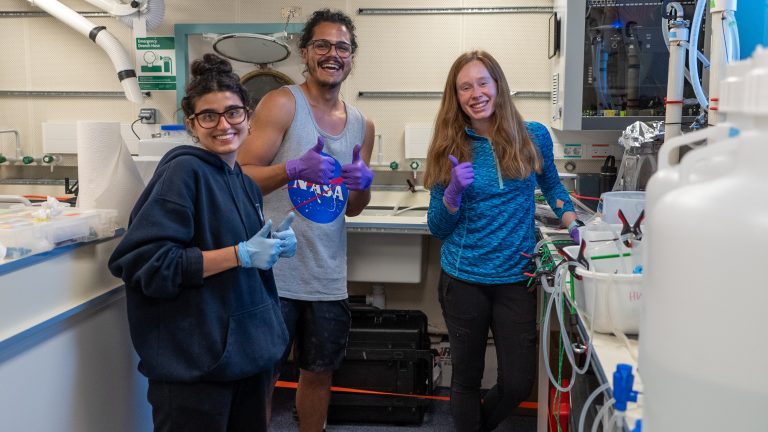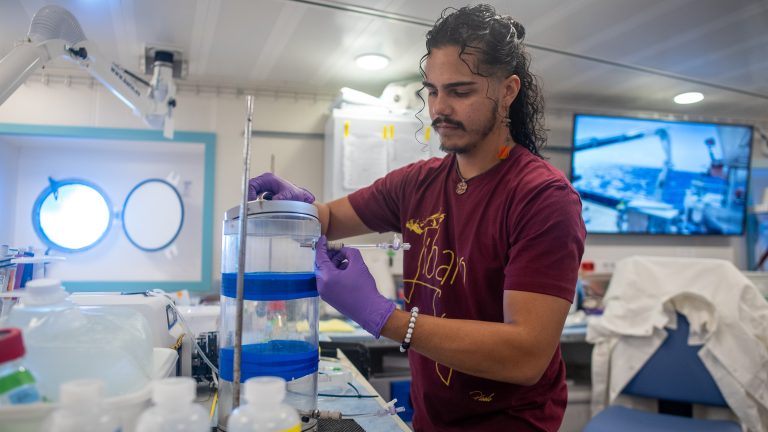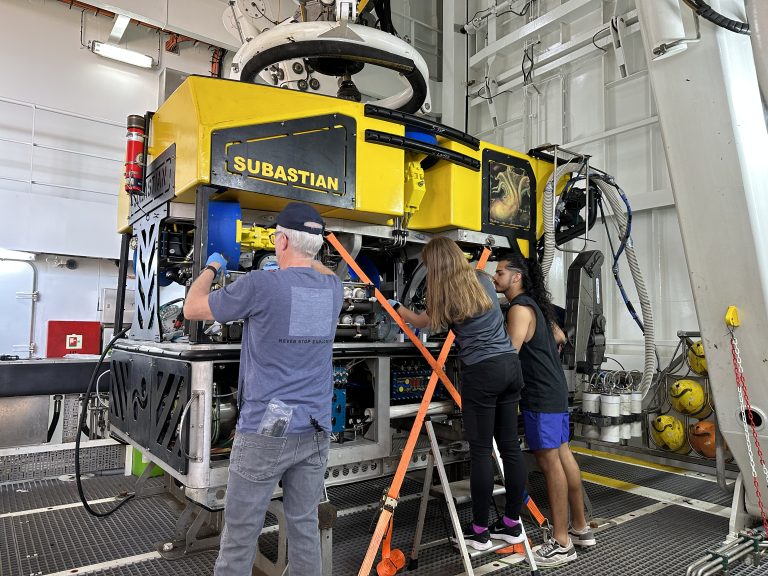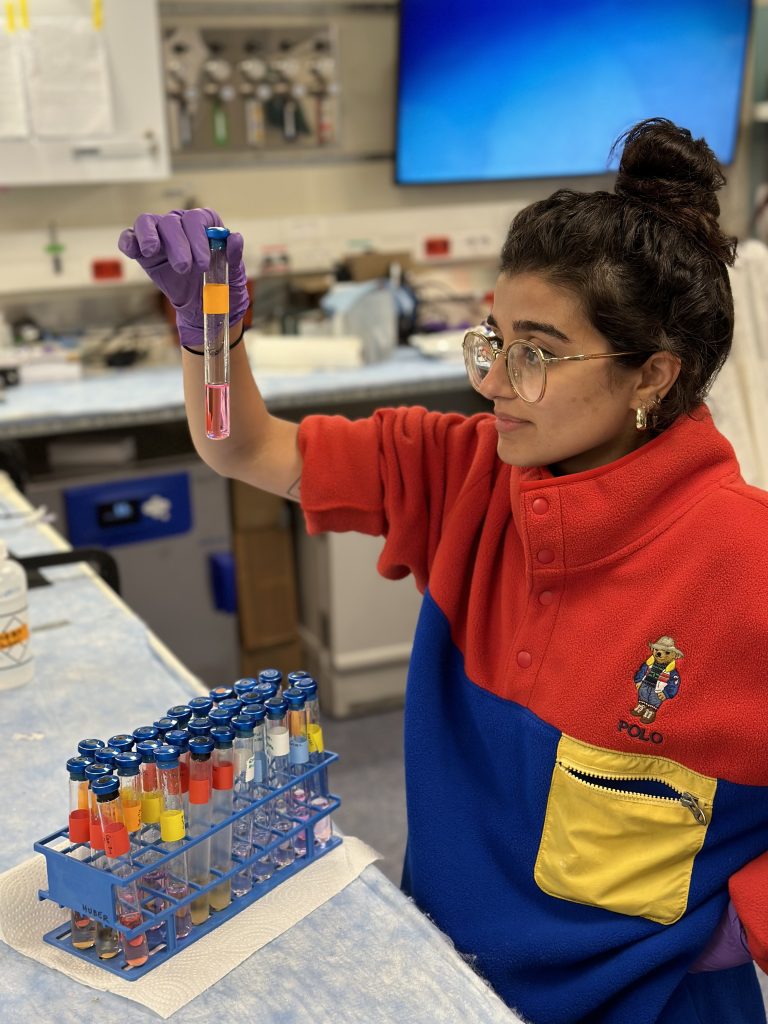Traducción al español disponible a continuación
Written by Marc A. Fontánez Ortiz
The deep sea is the largest ecosystem on Earth. It harbors a plethora of (bio)geochemical interactions, being the home to different life forms that range from shrimp to unicellular microorganisms. I am a geomicrobiologist who studies energy flow between water-rock-life interactions to understand how the environment shapes life and how life shapes the ecosystem. Therefore, I view the planet as an interconnected system with cooperation or competition between biotic and abiotic reactions. This expedition is one example of this approach, aiming to study the geomorphological structures, chemical signatures, and life in the deep and dark ecosystem hosted in oceanic core complexes from the Mid-Atlantic Ridge.

We are out here searching for serpentinization-driven hydrothermal venting. One feature of such vents is the high pH (10-11) and high concentration of hydrogen. These characteristics are especially interesting for scientists exploring prebiotic organic chemistry, as this highly reducing environment also supports the abiotic transformation of CO2 into CH4 and other small hydrocarbons (organic compounds)—a process thought to be important for the origin of life.
Within this dark biosphere, the mixing of cold bottom seawater (~2-4°C) and warm (<120°C), alkaline hydrothermal fluids provides a thermodynamic disequilibrium, meaning there is an abundance of chemical species that serve as energy-packed substrates for microbial life to thrive. Therefore, microbes that metabolize H2, CH4, and other hydrocarbons can reside in these ecosystems, but only if they can also manage the high pH. Unfortunately, not many examples of oceanic serpentinizing systems have been found. Our knowledge about the microbial community in these ecosystems mainly comes from studies of the Lost City Hydrothermal Field at the Mid-Atlantic Ridge. Due to the abundance of hydrogen and methane, both methane-producing and methane-consuming microbes have been detected at Lost City, as well as organisms oxidizing sulfide and hydrogen. Our geomicrobiology team is interested in learning more about these extremophiles and has brought a suite of tools to detect these microbes. One way we collected these microbes is by using the ROV SuBastian for vent fluid samples. Using these samples, we hope to grow microbes aboard the ship, analyze their genomic information, and study their activity.

By studying these unique organisms and their geochemical environment, we can also learn about early Earth and the origin of life. We do not know how life originated, but scientists think highly reducing environments such as deep-sea hydrothermal vents could have created favorable conditions for life to originate. Therefore, serpentinization-driven hydrothermal ecosystems are considered potential early Earth analogous due to their unique chemistry and the potential for abiotic organic synthesis, supplying some of the building blocks for life.

Considering that early Earth may have looked like a soup of molecules, scientists have proposed many different ideas about how life originated. One hypothesis is that ancient forms of genetic information (early precursors to nucleic acids, such as DNA and RNA, for example) were important for the development of unicellular life forms. While our team is studying the microbial communities of these primordial Earth analogs, we are also interested in the viral communities at these sites and how they impact their microbial and animal hosts.

Viruses are the most abundant biological entities found in the ocean, yet we know little about those found in the deep sea. Viruses are small packages of genetic information that require a host organism to survive. As such, it is important to consider the potential role of viruses in the origins of life because they blur the definition of what is alive, but do not quite exhibit the complexity. However, since the discovery of the giant Pandoravirus, opening Pandora’s box quite literally, we continue to learn about the potential of viruses as precursors to life as we know it.
Our combined efforts to study water-rock-life interactions on serpentinization-driven hydrothermal vents will help us understand the regimes in which microbial and viral communities are shaped by their geochemical environment. The insights we gain from this expedition will help us untangle the connections between energy transfer, early Earth environments, and primordial life, serving as a platform to experimentally explore the genesis of life in analog environments within our solar system.
Origen y vida: una mirada profunda al pasado
El fondo del océano es el ecosistema más grande del planeta Tierra. En él, se alberga una plétora de interacciones (bio)geoquímicas, siendo el hogar de distintas formas de vida, desde camarones a microorganismos unicelulares. Soy un geomicrobiólogo que estudia el flujo de energía entre las interacciones del agua de mar, las formaciones geológicas y la vida. Esto, para entender cómo el entorno influye en la vida, y como la vida influye en el ecosistema. Por tanto, veo al planeta como un sistema interconectado de cooperaciones o competencias entre reacciones bióticas y abióticas. Esta expedición es un ejemplo de esta perspectiva, puesto que intentamos estudiar estructuras geomorfológicas, señales químicas y la vida en el profundo y oscuro ecosistema alojado en algunos de los megamuliones de la dorsal mesoatlántica.
Estamos buscando fuentes hidrotermales activadas por serpentinización, y una característica de dichas ventilas es el alto pH (10-11) y la alta concentración de hidrógeno. Estas propiedades son especialmente interesantes para los científicos estudiando la química orgánica prebiótica dado que este ambiente altamente reductor, también promueve la transformación del CO2 a CH4 u otros hidrocarburos pequeños (compuestos orgánicos), proceso importante para el origen de la vida.
Dentro de esta oscura biosfera, la mezcla del agua fría del mar (~2-4°C) con el cálido (<120°C) y alcalino fluido hidrotermal promueve un desequilibrio termodinámico, o bien sea, una abundancia de especies químicas empacadas de energía, que sirvien de sustrato para la proliferación microbiana. Por tanto, los microbios que pueden metabolizar el H2, CH4 y otros hidrocarburos, pueden vivir en estos ecosistemas, pero sólo si consiguen manejar el alto nivel de pH. Desafortunadamente, no se han encontrado muchos ejemplares de sistemas de serpentinización marina. Nuestro conocimiento sobre la comunidad microbiana en estos ecosistemas viene mayormente de los estudios hechos en el campo hidrotermal, Ciudad Perdida, encontrada en la dorsal mesoatlántica. Dado a la abundancia de hidrógeno y metano, tanto microbios que consumen como los que producen metano pueden ser detectados en la ventila Ciudad Perdida. Asimismo, se encuentran organismos que oxidan sulfuro e hidrógeno. Nuestro equipo de geomicrobiólogos está interesado en aprender más sobre estos extremófilos, y ha traído herramientas aptas para detectar estos microbios. Una forma en la que los detectamos es mediante el vehículo operado de forma remota, SuBastián, para colectar muestras de fluidos hidrotermales. Esperamos utilizar estas muestras para poder cultivar microbios durante la expedición, analizar su información genética, y estudiar su actividad.
A través del estudio de estos organismos peculiares, junto al de su entorno geoquímico, podremos aprender sobre la Tierra primordial y el origen de la vida. Aunque no sabemos cómo la vida comenzó, los científicos piensan que ambientes altamente reductores, como los ventilas hidrotermales en el fondo del océano, pudieron haber propiciado las condiciones necesarias para el origen de la vida. Por tanto, los ecosistemas hidrotermales donde ocurre serpentinización pueden considerarse como análogos de la Tierra primordial dado a su química y su potencial de sintetizar compuestos orgánicos de forma abiótica, supliendo así algunos de los elementos necesarios para la vida.
Considerando que la Tierra primordial posiblemente fue una sopa de moléculas, científicos han propuestos distintas ideas sobre como la vida se originó. Una hipótesis es que formas ancestrales de información genética (los precursores de ácidos nucleidos, así como el ADN, el ARN) pudieron ser importantes para el desarrollo de la vida unicelular. Si bien nuestro equipo está estudiando la comunidad microbiana de estos análogos de la Tierra primordial, también estamos interesados en conocer la comunidad viral, y cómo impactan sus huéspedes microbianos y animales.
Los virus son la entidad biológica más abundante en el océano, sin embargo, conocemos muy poco sobre aquellos encontrados en el lecho marino. Los virus son pequeños paquetes de información genética, y requieren un organismo huésped para sobrevivir. Es importante considerar la contribución que potencialmente tuvieron durante el origen de la vida ya que desafían la definición de lo que es vivo, pero no necesariamente exhiben la complejidad necesaria para ser considerados seres vivos. No obstante, desde el descubrimiento del gigante Pandoravirus, que literalmente abrió una caja de Pandora, hemos continuado aprendiendo sobre el potencial de los virus como los precursores de la vida tal como la conocemos.
Nuestros esfuerzos unidos en el estudio de las interacciones entre el agua de mar, las rocas y la vida en ventilas hidrotermales activadas por serpentinización nos ayudarán a entender los regímenes en los cuales las comunidades microbianas y virales son formadas, y su ambiente geoquímico. Nuestros hallazgos de esta expedición pueden ayudar a desencadenar las conexiones entre la transferencia de energía, las condiciones primitivas de la Tierra, y la vida primordial, sirviendo como una plataforma para explorar experimentalmente la génesis de la vida en ambientes análogos dentro de nuestro sistema solar.

